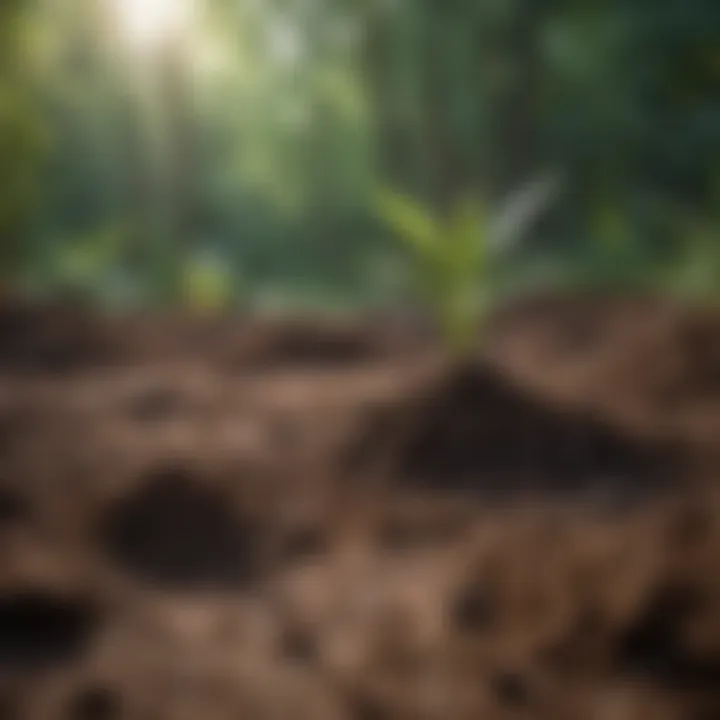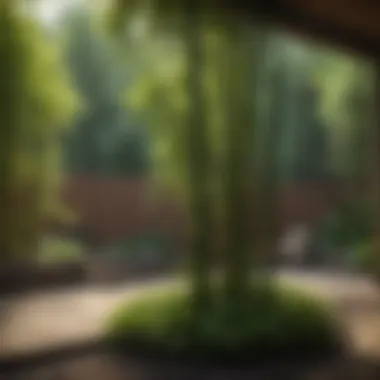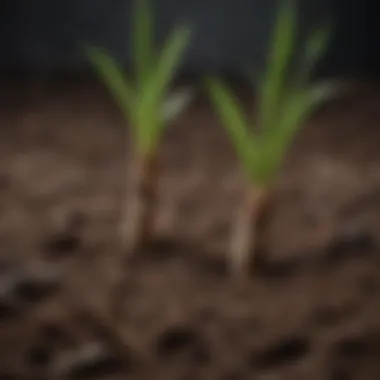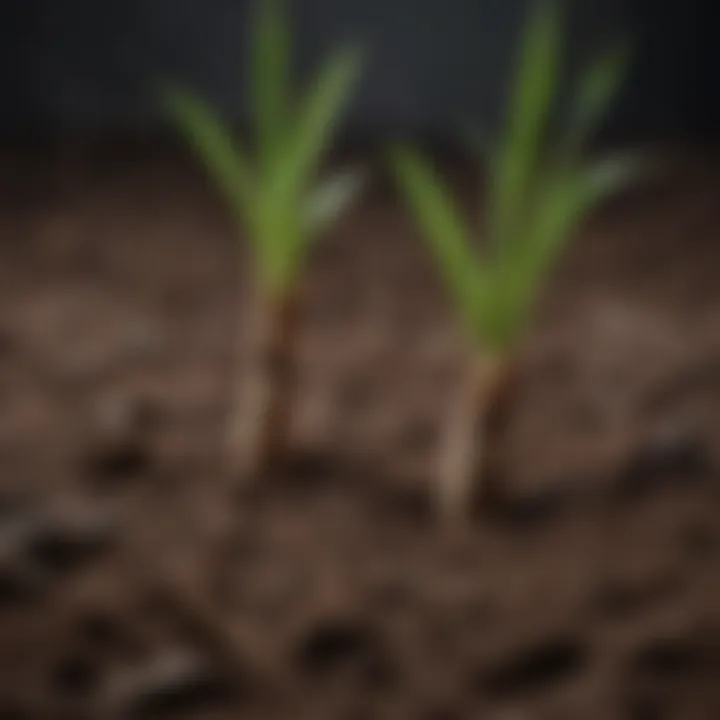Mastering the Art of Bamboo Planting Techniques


Intro
Bamboo, often revered for its versatility, has carved out a niche in gardens and landscapes alike. It stands tall as not just a plant but also a cultural icon in several societies, symbolizing strength and resilience. However, growing bamboo isn't merely a matter of tossing some seeds in the ground and calling it a day. It requires a gantlet of considerations including site selection, soil preparation, and ongoing care to ensure that your bamboo thrives.
This guide aims to navigate you through the various stages of planting bamboo, bridging the gap between theory and practical execution. To get started on this leafy journey, let’s first explore Design Inspiration that can make your bamboo garden flourish.
Design Inspiration
Trending Styles
When envisioning your bamboo-infused landscape, there are several styles that can accentuate its natural beauty. Whether you're going for a traditional East Asian garden or more of a modern minimalist approach, bamboo can fit right in.
- Zen Gardens: Incorporating bamboo into a Zen garden can create a tranquil atmosphere. Use gravel or sand along with strategically placed stones to complement the bamboo.
- Tropical Vibes: Pairing bamboo with palm trees and vibrant flowers can transform your garden into a tropical paradise.
- Contemporary Themes: For a modern take, bamboo fencing or planters can provide a sleek look while serving a functional purpose.
Color Palettes
Bamboo naturally thrives amidst various colors. Here’s how to blend colors for a striking visual composition:
- Earth Tones: Greens, browns, and beige highlight bamboo’s organic qualities and work well in more natural settings.
- Bold Contrasts: Using bright-colored flowers or even planters can make your bamboo stand out, creating an eye-catching focal point in your landscape.
- Monochromatic Schemes: Playing with shades of green can give your garden a serene and sophisticated appearance, letting the bamboo shine.
"A well-planned bamboo garden is like a symphony; each element plays its part in creating a harmonious scene."
Practical Tips
Maintenance & Care
Once your bamboo is planted, ongoing maintenance is key to a healthy and vigorous plant. Here are some useful pointers:
- Watering: Young bamboo plants require regular watering. Make sure the soil is consistently moist but not waterlogged.
- Fertilization: During the growing season, apply a high-nitrogen fertilizer to support growth. Look for organic options to keep your garden sustainable.
- Trimming: Regular trimming encourages healthy growth and can help prevent pests.
Budgeting & Planning
Bamboo can be economical, but planning is essential. Here’s a simple breakdown to guide your budgeting process:
- Seed or Seedling Cost: Depending on the species, prices can vary widely, from a few dollars to several hundred for exotic types.
- Soil Preparation: Investing in quality soil can make a significant difference, ranging anywhere from $50 to $200.
- Maintenance Costs: Factor in ongoing costs like water, fertilizer, and tools needed for upkeep. Budgeting around $100 annually should give you a good cushion.
Successful bamboo growth hinges not just on planting but also on thoughtful design and diligent care. This guide has merely scraped the surface, but it provides a solid foundation as you embark on your bamboo-planting venture.
Understanding Bamboo
Understanding bamboo is key to successfully incorporating this plant into your landscape. Not only does it offer aesthetic value, but it also plays a significant role in environmental sustainability. Its rapid growth rate allows for quick hedging or landscaping effects, making it a favorite among homeowners and garden enthusiasts alike. This section unpacks essential elements about bamboo that every gardener should know, ensuring a smooth and rewarding planting experience.
Overview of Bamboo
Bamboo, a member of the grass family, represents over 1,400 species found in numerous climates worldwide. It’s often mistaken for a tree, but it retains the grass-like qualities while boasting a unique structure that allows it to reach impressive heights. Some types of bamboo can grow several feet in just a single day under optimal conditions. Additionally, bamboo’s fibrous root system holds the soil together efficiently, reducing erosion in garden areas prone to washing away. When cultivated right, bamboo can thrive in both tropical and temperate regions, making it a versatile choice for many landscapes.
Types of Bamboo
When selecting bamboo, consider the type that best suits your climate and intended use. There are two main categories: clumping and running bamboo.
- Clumping Bamboo: This type grows in a tight cluster, making it less invasive. Varieties like Bambusa textilis and Fargesia robusta are well-suited for smaller gardens. They can serve decorative purposes or provide some privacy without overwhelming the space.
- Running Bamboo: Characterized by their aggressive growth, running varieties such as Phyllostachys aurea stretch their roots far and wide. Although they can create privacy screens effectively, they require containment measures due to their potential to become unruly.
It is essential to research and choose wisely; understanding the tendencies of each type ensures you don’t end up with a bamboo overly eager to spread.


Characteristics and Benefits
Bamboo comes with a range of benefits that extend beyond its visual charm:
- Quick Growth: One of nature’s fastest-growing plants, it can reach full maturity in as little as three to five years, allowing for immediate landscaping results.
- Sustainability: Its ability to sequester carbon and produce oxygen makes it an eco-friendly choice. Bamboo cultivations can serve as habitats for various wildlife as well.
- Versatility: This adaptable plant can be used for fencing, screens, or as a decorative feature to complement any outdoor space. Moreover, some varieties can even be harvested for construction or crafting purposes.
"Bamboo is like a treasure trove waiting to be fully discovered in your garden. It stands as proof that beauty and utility can work hand in hand."
By grasping these fundamental aspects about bamboo, you prepare yourself for a rewarding planting experience that celebrates both beauty and function in your landscape.
Choosing the Right Bamboo
Choosing the right bamboo is crucial for the success of your gardening venture. Not all bamboo species thrive in every environment, and picking an unsuitable variety can lead to disappointment or extra maintenance work. Each type of bamboo brings its own flavor to landscaping, impacting the overall aesthetic and ecological balance. Thus, the selection process should consider your specific needs, local conditions, and intended use of the bamboo.
When selecting bamboo, it’s important to account for factors such as growth conditions and space requirements. The wrong choice can cause plants to struggle or even fail to grow, leading to wasted time and resources. Additionally, certain species can become invasive if not properly managed. With the right variety, however, bamboo can provide a visually stunning and environmentally friendly addition to your garden, serving purposes from natural privacy screens to ornamental features.
Assessing Your Space
Before choosing a bamboo species, understanding your space is essential. Start by looking at the location where you plan to plant. Is it sunny, shaded, or a mix? Most bamboo varieties prefer full sun but can tolerate partial shade; however, the amount of sunlight you get can affect growth rates significantly.
You should also consider:
- Soil Type: Is the soil sandy, loamy, or clay? Bamboo generally enjoys well-draining soil enriched with organic materials.
- Space: Some bamboos grow tall and wide, while others are more compact. Think about how much space you have and how much you are willing to maintain.
- Water Access: Bamboo loves moisture but does not want to sit in water. Ensure there's a good drainage system in place, especially if you’re in an area prone to flooding or heavy rainfall.
Assessing these elements can help narrow down which bamboo varieties will thrive in your specific environment, financial commitement and personal preference for aesthetics are also key considerations.
Bamboo Varieties for Different Climates
When it comes to bamboo, one size does not fit all—different climates require different varieties. Knowing the climate in which you live will guide your decision.
- Cold Climates: If you're in a region prone to frost, you might want to look into varieties like Fargesia, which are hardy and can survive low temperatures without much fuss.
- Tropical Climates: For sunnier, warmer locales, consider species such as Guadua or Bambusa, which flourish in those conditions and can stunt growth when the thermometer drops too low.
- Dry or Arid Regions: Varieties like the Dendrocalamus can withstand some drought conditions and need less moisture than others. Consider this if your area faces water scarcity.
These differences highlight how essential it is to match the bamboo to your local conditions. A single right choice can set the stage for a lush and thriving green backdrop in your garden, making you the envy of the neighborhood.
"Selecting the right bamboo variety is an investment in both your landscape and your time, ensuring your garden flourishes for years to come."
By mindfully assessing your space and understanding climate specifics, your journey to cultivating bamboo can be both simple and rewarding.
Preparing for Planting
Preparing for planting bamboo is like laying the groundwork for a beautiful melody. Each note matters, and if you skip a few, the whole symphony can sound off. Understanding the steps to prepare can lead to a thriving bamboo grove that's the envy of your neighbors. This stage is not just important; it's crucial for ensuring you cultivate bamboo that grows strong and healthy. Here’s a breakdown of what to keep in mind as you gear up for this green endeavor.
Site Selection and Soil Preparation
The first order of business is choosing the right site. Bamboo isn’t overly picky, but it does thrive best in certain conditions. Look for a location that receives plenty of sunlight—about 6 hours daily. A spot with partial shade works as well, but don’t expect those tall, lush growths if you’re planting in a shaded corner of your yard.
Next up is soil preparation. This is critical since bamboo prefers loamy, well-draining soil that retains some moisture without becoming soggy. Here are some important points to consider:
- Check Soil pH: Bamboo tends to enjoy a slightly acidic to neutral pH range (between 5.5 and 7). Testing kits are easily available, usually at local garden centers.
- Amend the Soil: If your soil is compacted or heavy, mix in some compost or well-rotted manure. This adds nutrients and improves drainage, giving your bamboo a helpful boost.
- Tilling: Turn the soil at least 12 inches deep. This aeration will help the roots expand well once planted.
Once you’ve got your site and soil sorted, you’re in a solid position to plant.
Gathering Necessary Tools and Materials


Now that your site is picked and ready, the next step is to gather the tools and materials you need. It may seem minor, but having everything at hand before you start is half the battle won. Here’s a checklist to help you out:
- Shovel and Trowel: Essential for digging and planting.
- Rake: For leveling the soil surface post-tilling.
- Water Hose or Drip Irrigation System: Bamboo thrives with regular watering.
- Mulch: Organic mulch can help keep moisture in and reduce weed growth.
- Compost: To enrich the soil during planting.
- Labeling Stakes: If you're planting different varieties, these will help you keep track of what’s what.
Gather these essentials before digging in. You’ll find the planting process goes smoother when you’re prepared.
Important Note: Failing to select the right site or prepare the soil adequately can lead to poor growth and might even kill your bamboo plants. This preparation phase is critical to avoid such pitfalls.
By taking the time to select your site carefully and preparing your soil, along with having the right tools, you’ll set the stage for a successful bamboo planting experience. With these steps behind you, you can confidently proceed to the planting techniques that will follow.
Planting Techniques
When it comes to successfully cultivating bamboo, mastering the planting techniques is non-negotiable. The process encompasses more than just setting a few seeds in the soil. It requires a thoughtful approach tailored to bamboo’s unique growth habits and environmental needs. By implementing effective techniques, you not only ensure the bamboo's survival but also pave the way for a thriving, lush landscape that can dramatically enhance your property’s aesthetic appeal and functionality.
A well-planned planting strategy minimizes the risk of future problems such as overcrowding or disease, making it an essential foundation in your bamboo journey.
Step-by-Step Planting Process
To navigate the intricacies of planting bamboo, it's paramount to follow a methodical approach. Here’s a step-by-step breakdown to help you through:
- Select Healthier Rhizomes or Seedlings: Begin by choosing robust seedlings or rhizomes from a reputable nursery. Inspect them thoroughly for signs of rot or disease.
- Prepare the Planting Site: Choose a spot that gets ample sunlight, as bamboo thrives in bright conditions. Ensure the soil is loose, well-draining, and rich in organic matter. Have a pH test done if uncertain about the soil quality.
- Digging the Hole: When planting bamboo, dig a hole that is about two times wider than the rhizome or root ball. The depth should be enough to cover the roots fully but avoid burying the plant too deep to prevent rot.
- Planting: Place the bamboo in the center of the hole, spreading its roots gently to encourage outward growth. Backfill the hole with soil while ensuring there are no air pockets around the roots.
- Watering: After planting, water the bamboo generously to settle the soil around the roots. Follow up with regular watering to keep the soil moist but not soggy.
- Mulching: Apply a layer of organic mulch around the base of the plant. This will help retain moisture and reduce weed competition.
By following these well-defined steps, you set your bamboo up for success from day one.
Spacing and Arrangement
Understanding the importance of spacing and arrangement when planting bamboo is vital. Each variety of bamboo has a different spacing requirement, influenced by its growing pattern and ultimate size. Here’s a guide to assist in arranging your plants effectively:
- Consider Growth Habits: Bamboo can be categorized into clumping and running varieties. Clumping bamboo tends to stay in a more contained area, while running bamboo spreads aggressively. Be sure to check the variety you’re planting and space accordingly.
- Ideal Spacing: A general rule of thumb is to space clumping bamboo about three to five feet apart, whereas running bamboo varieties might require a distance of six to ten feet between plants. This minimizes competition for resources.
- Creating a Visual Impact: Strategically layering taller varieties behind shorter ones creates depth and dimension in your garden. This not only optimizes light for all plants but also facilitates an appealing visual flow.
- Wind Protection: If you live in a windy area, consider planting bamboo in a staggered formation to provide a natural windbreak, which helps protect more fragile plantings.
Remember: If you have sufficient space, variety is key. Mixing different species can elevate the aesthetic appeal and promote a biodiverse environment.
In essence, the meticulous planning of planting techniques, spacing, and arrangement lays the groundwork for a flourishing bamboo garden, promising beauty and sustainability.
Caring for Bamboo Post-Planting
Caring for bamboo post-planting is crucial for establishing a healthy, thriving plant that can flourish in your landscape. Once the initial planting phase is complete, the focus shifts to nurturing the bamboo so that it can become a stunning focal point in your garden. It's not just about watering; it’s about understanding the intricate needs of this fascinating plant. Bamboo has a reputation for being fast-growing and resilient, but without proper care, it may not reach its full potential. The right aftercare enhances growth, encourages strong root systems, and ensures that bamboo stays healthy year after year.
Watering and Nutrient Requirements
Bamboo requires regular watering to establish strong roots, especially during its early growth stages. However, it’s important to strike a balance; too much water can lead to root rot while too little can cause stress on the plant. A good rule of thumb is to keep the soil consistently moist but not soggy.
- Initial Watering: For newly planted bamboo, water deeply at least two to three times a week during the growing season. This helps to encourage the roots to grow deeper into the soil where moisture is more stable.
- Seasonal Adjustments: As bamboo matures, you can adjust your watering schedule. In peak summer, when temperatures rise, it may require more frequent watering. Conversely, during cooler months, the frequency can be reduced.
Adding nutrients is another key aspect of bamboo care. Using a balanced fertilizer can provide your bamboo with essential nutrients, aiding in its rapid growth and lush greenery. Typically, a slow-release fertilizer with equal parts nitrogen, phosphorus, and potassium is ideal. Here's a simple guideline for fertilizing your bamboo:
- Spring Application: Apply a slow-release fertilizer in early spring as the plant resumes growth.
- Mid-Season Boost: Consider a light feeding with a liquid fertilizer during peak growth times, usually in late spring to early summer.
Remember to monitor growth and adjust the nutrient regimen as recommended by soil tests. Successful bamboo growth hinges not just on water, but also on the right nutrition.
Controlling Growth and Containment
Bamboo can indeed be a beast when it comes to growth. If left unchecked, certain species might spread aggressively, leading to an overwhelming thicket that you didn’t plan for. This is where controlling growth and containment becomes an essential step in bamboo care.


- Choosing the Right Species: It’s crucial to select clumping varieties if you want to maintain a controlled garden. Running bamboo spreads through underground rhizomes, which may require more rigorous containment measures.
- Physical Barriers: Installing root barriers — these are typically made from hard plastic or metal — around the planting area can help prevent unwanted spreading. Ideally, barriers should extend at least 2 feet deep into the ground.
- Regular Maintenance: Regularly prune back any shoots that wander beyond the desired area. Late winter to early spring is usually a good time for pruning, ensuring you cut back to promote fresh growth.
"Bamboo is not just a plant; it’s an experience. Controlling its flow can transform your garden into a serene retreat."
In summary, caring for bamboo post-planting requires a conscious approach to watering and nutrient management as well as growth control. By paying attention now, your bamboo can grow into a beautiful asset in your landscape, providing shade and style for years to come.
Pest and Disease Management
Managing pests and diseases is a critical component of maintaining a healthy bamboo garden. Certain insect infestations and diseases can quickly turn your flourishing bamboo into a shadow of its former self, potentially compromising the aesthetic and environmental benefits it provides. Homeowners and gardening enthusiasts must familiarize themselves with common adversaries that threaten bamboo, as well as strategies for mitigating potential hazards. Neglecting this aspect can lead to extensive damage, affecting not only the bamboo but the garden ecosystem as well.
Common Pests Affecting Bamboo
Bamboo is not immune to the clutches of pests; in fact, some of the most common culprits include:
- Bamboo Mites: These microscopic pests tend to reside on the undersides of leaves, robbing the plant of vital nutrients and moisture. You might notice yellowing leaves or a dust-like appearance on the foliage.
- Bamboo Borers: These pests are particularly troublesome, as they burrow into the stems, making their presence known by causing hollowed-out internodes. Their insatiable appetite can weaken the structural integrity of the bamboo.
- Aphids: Small and often overlooked, aphids cluster on new shoots and leaf buds, sucking sap and weakening the overall vigor of the plant. Look out for sticky honeydew left behind, attracting even more pests.
- Scale Insects: These pests have a waxy coating and often go unnoticed until they have multiplied extensively. Their feeding habits can lead to stunted growth and premature leaf drop.
Understanding the signs of an infestation is crucial, as early detection can make a world of difference in managing these issues effectively.
Preventative Measures and Treatments
Preventing pest problems before they start is often wiser than reacting too late. Here are a few practical measures:
- Regular Inspections: Routinely check your bamboo for signs of pests. Early diagnosis allows for timely treatment, thus reducing the risk of widespread damage.
- Promote Biodiversity: Introduce companion plants that naturally deter pests. For example, marigolds are known to repel whiteflies and nematodes, providing a natural barrier around your bamboo.
- Use Insecticidal Soap: This gentle solution effectively kills soft-bodied insects like aphids and mites without being overly harsh on your plants. Spray it on affected areas for best results.
- Introduce Beneficial Insects: Ladybugs and lacewings can help keep pesky aphid populations in check. Consider attracting these allies by planting flowers nearby.
- Maintain Healthy Plants: Stress can attract pests, so ensure your bamboo is well-watered and receiving adequate nutrients. A strong plant is less likely to succumb to infestations.
"An ounce of prevention is worth a pound of cure."
In summary, staying vigilant against pests and diseases will go a long way in preserving the health of your bamboo. The more informed you are, the better equipped you'll be to maintain a thriving and vibrant bamboo garden.
Sustainable Bamboo Gardening
When it comes to planting bamboo, the concept of sustainability is pivotal in fostering a thriving environment as well as creating beautiful landscapes. Bamboo is often touted as one of the most sustainable plants due to its rapid growth rate and ability to regenerate without needing replanting. This section will delve into the environmental considerations and landscaping strategies that not only promote the growth of bamboo but also honor the planet.
Environmental Considerations
Bamboo is truly a marvel of nature. It can grow up to three feet in a single day, depending on the species and conditions. This impressive growth makes it one of the fastest-growing plants on the planet. In terms of environmental benefits, here are some noteworthy points:
- Carbon Sequestration: Bamboo forests capture more carbon dioxide than a typical tree, thus playing a significant role in combating climate change.
- Soil Erosion Prevention: The extensive root system of bamboo holds the soil firmly, reducing erosion. This is particularly beneficial in areas prone to heavy rains.
- Biodiversity: Bamboo provides habitat for a variety of wildlife, including birds, insects, and larger mammals, thus enhancing local biodiversity.
- Water Conservation: Bamboo can help in managing water resources effectively. Its root structure aids in rainwater absorption, maintaining groundwater levels.
To harness these benefits, it is crucial to select the right bamboo species based on your local environment and soil type. For instance, Fargesia robusta is an excellent choice for cooler climates while Bambusa vulgaris thrives in warmer regions.
"Opting for bamboo isn’t just a design decision; it’s a choice for the planet."
Using Bamboo in Landscaping
Integrating bamboo into your landscape offers both aesthetic and practical advantages. Bamboo can create stunning focal points, privacy screens, and even windbreaks. Here are some ways to utilize bamboo in landscaping:
- Natural Privacy Screens: Tall species like Phyllostachys aurea can provide a lush, green wall, effectively blocking unwanted views while still letting light filter through.
- Aesthetic Appeal: The sleek appearance of bamboo adds a unique texture to gardens. Its gentle swaying in the breeze creates a dynamic visual and auditory experience.
- Versatile Uses: Beyond being just a green ornamental, bamboo can serve functional roles—think trellises for climbing plants, or even handcrafted furniture from the harvested materials.
When establishing bamboo in a landscape, consider its spreading nature. Some varieties are running types, which can take over spaces if not managed properly. To avoid this, options like clumping bamboo should be considered. Managing the growth through barriers or regular maintenance becomes key in maximizing its benefits while minimizing any adverse impact on surrounding flora.
In summary, crafting a sustainable bamboo garden requires thoughtful planning, dedication to environmental stewardship, and an appreciation for the versatility of bamboo. With its numerous advantages, this plant stands out as a powerful ally in building a greener world while enhancing our living spaces.
Finale
Bamboo's rapid growth and environmentally friendly nature offer a wealth of benefits. It serves multiple purposes, from enhancing aesthetic appeal to contributing to erosion control. Furthermore, its ability to sequester carbon and replenish soil nutrients makes it a sustainable choice for those mindful of their environmental footprint.
Key elements to take away:
- Diversity and Versatility: With various species available, understanding local climate adaptation is key. Each type of bamboo presents its own advantages, making thorough research imperative.
- Preparation is Critical: From site selection to tools and materials, laying down a solid groundwork sets you up for success.
- Seasonal Considerations: Recognizing the timing of planting and the subsequent maintenance routines is vital in fostering healthy growth.
- Pest Awareness: Knowledge of potential threats and how to manage them ensures that your bamboo plants thrive.
- Sustainable Practices: Incorporating bamboo sustainably not only beautifies your surroundings but also supports ecological balance.
To encapsulate, integrating bamboo into your landscape provides a unique opportunity to explore a plant that is both functional and beautiful. The concluding thoughts highlight the interconnectedness of preparation, execution, and ongoing care, which all contribute to creating a thriving bamboo environment. Remember, a well-planned approach and continuous knowledge will yield the best results. Happy gardening!















